Team-BHP
(
https://www.team-bhp.com/forum/)
I saw this interesting insect on my curry leaf plant this week. I couldn't see any eggs. Is it a visitor or someone who will destroy my plant? I loved the colors!!
https://youtu.be/kDoW3cHxWns 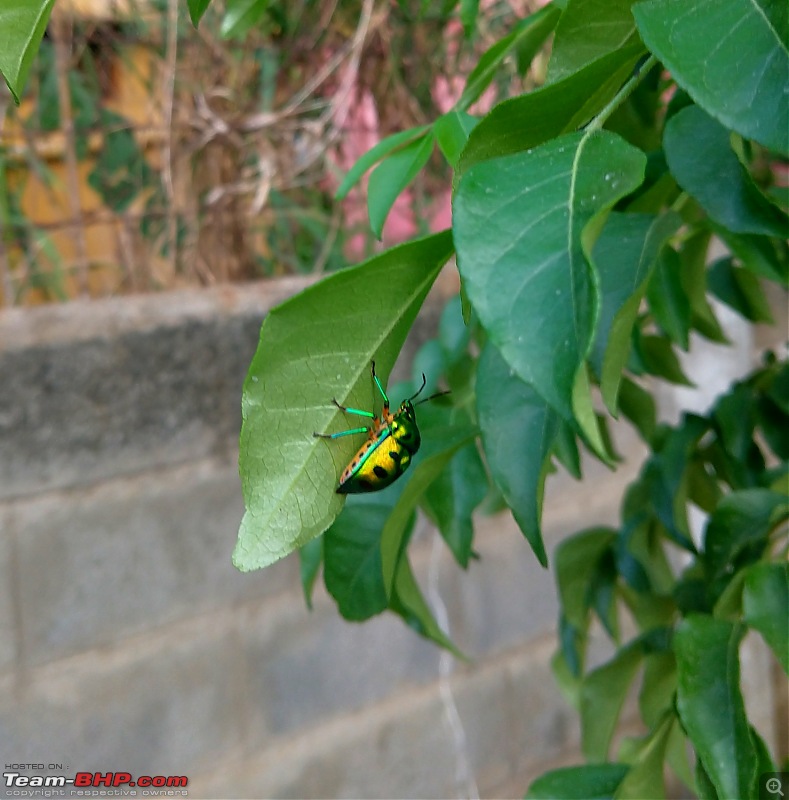
I need one more plant recognition help.
I easily forget what I've planted in some pots and as they sometime sprout after a long time, I can't figure out whether it is something I planted or a weed from the soil I took.
Any pointers as to whether this is a weed or a plant or a herb?
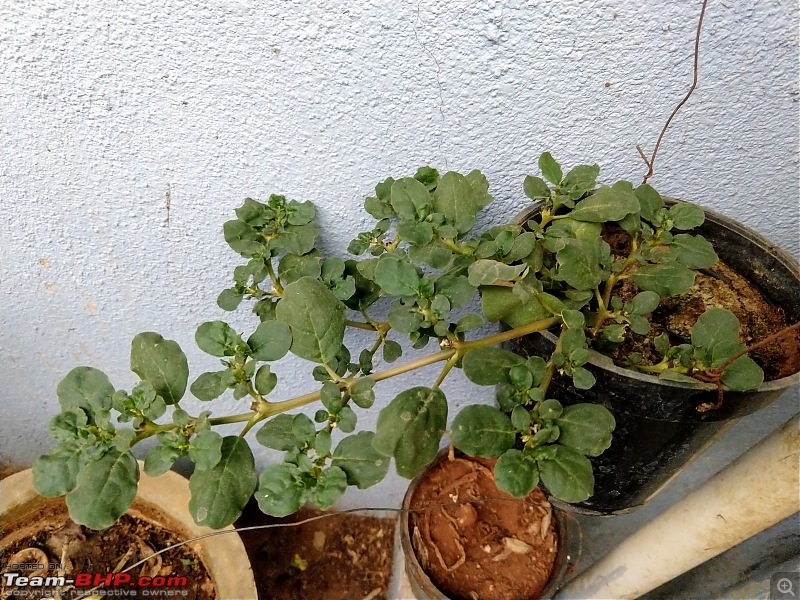
Quote:
Originally Posted by BenjiRoss
(Post 4439192)
I need one more plant recognition help.
I easily forget what I've planted in some pots and as they sometime sprout after a long time, I can't figure out whether it is something I planted or a weed from the soil I took.
Any pointers as to whether this is a weed or a plant or a herb? Attachment 1787198
|
This is Desert Hawk Purslane - Trianthema portulacastrum
It is a common weed and is spread all across our bylanes
https://www.google.com/search?biw=13...lHeYe02SynTLM: http://tropical.theferns.info/viewtr...portulacastrum "Horse purslane is an annual, succulent, prostrate or ascending herb, often much-branched, growing up to about 60 cm tall, with a firm taproot[310].
The plant is harvested from the wild for local use. It has a number of medicinal virtues and is sometimes also eaten, though there are conflicting reports on the wisdom of this. The dried plants are sometimes traded for their medicinal qualities[299]"
Here is an image
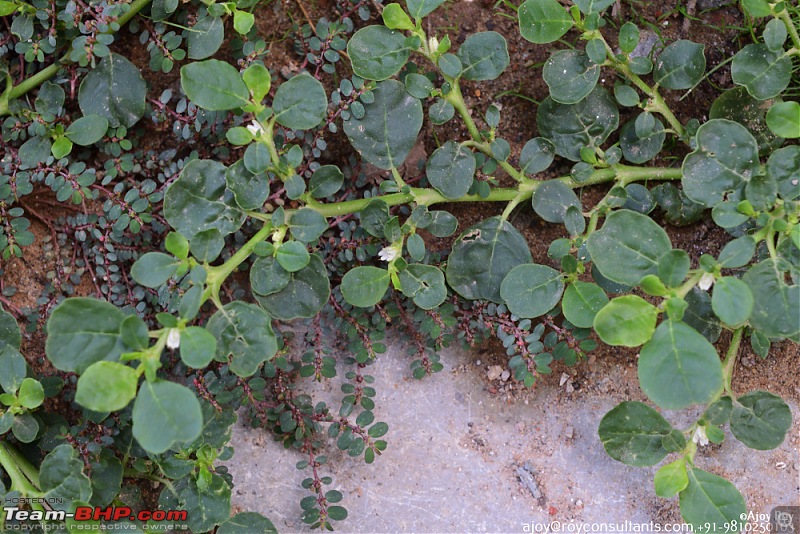
Quote:
Originally Posted by swissknife
(Post 4417073)
Does anyone have experience in using Coco pith in grow bags for a terrace kitchen garden? The ratio of pith to vermi-compost is something that I am concerned about. The ratios that are suggested seem be so varied that I am unsure of what is optimum.
|
Coco peat will only help in providing a combination of good drainage with water holding capacity. Coco peat doesn't provide any nutrients.
If you have home made compost just use 1:1 ratio. If you buy compost then you can use 1 compost: 4 coco peat
Line the bottom of the grow bag with carbon rich material i.e. the browns dry leaves/straw/cardboard etc. It will help hold onto water.
Then add a layer of greens i.e. leaves/vegitable peels/banana peals. This yer will decompose over time and provide nutrition to roots when they get there.
The add coco peat and compost (layers or mixed) till top of the grow bag.
The best thing after vermicompost I have found is Panchagavya.
Add Panchagavya to cocopeat and vermicompost and once or twice a month give a dose of 1 (panchagavya) :30 water to the plants.
If you have bugs on the plants add a drop of dish soap to the solution and spray it on foliage
The water on top of Dahi also makes a great addition to coco peat. It add beneficial bacteria to the grow bags.
Hi, Can the experts here please give me tips on how to grow and take care of an avocado plant? I planted an avocado seed few months back and it sprouted now. I'm absolutely clueless as to what climate requirements are needed for the plant to grow. How much sun light is required, how much water is required, in what kind of conditions/temperature does it grow, what fertilizer to use, etc?
I'm aware that most avocado plantations in India are in the highlands. So is the climate in Kerala suitable for the plant to grow. Requesting advice from experienced folks in the forum.
Quote:
Originally Posted by maddy42
(Post 4052936)
Anyone out here has been succesful with having a vermicompost bin?
My query is how to setup one, precautions to be taken, feed to be fed and harvesting of the soil.
|
Maybe this thread can answer your queries.
Related thread
Quote:
Originally Posted by Flyer
(Post 4446522)
Hi, Can the experts here please give me tips on how to grow and take care of an avocado plant? I planted an avocado seed few months back and it sprouted now. I'm absolutely clueless as to what climate requirements are needed for the plant to grow. How much sun light is required, how much water is required, in what kind of conditions/temperature does it grow, what fertilizer to use, etc?
I'm aware that most avocado plantations in India are in the highlands. So is the climate in Kerala suitable for the plant to grow. Requesting advice from experienced folks in the forum.
|
Avocado, or Butter Fruit, as it is known locally, grows well in Bangalore. But, most plants are from cuttings.
Grown from seed, avocado takes a long time to fruit. So now you need to wait ... and wait ... and wait!
Quote:
Originally Posted by Prowler
(Post 4429335)
It has been a long time since I saw your post DerAlte Sir. How is your Safari ?
As usual - thorough message crammed with details.
I thought growing Cucurbitae calls for more care and work. I tried my hand with Pumpkin to no joy.
|
Safari is still going strong! :)
Cucurbitae don't need much specific care.
1. Cucurbitae are most affected by fruit fly, which lay eggs when the fruit is small and tender - though this can happen later too
2. To prevent this, one way is to cover the fruit with a paper cover - before the fruit flies get a chance to lay eggs
3. You may need to get a pheromone trap & lure - available from PCI (Pest Control India). Specifically, get lure for Oriental Fruit Fly - the one that affects cucurbitae
4. Cucurbitae throw up male flowers mostly. To get more female flowers, you need to prune the vine at the 7th node from root first, and then 7th node of every branch that is thrown out. This increases the female flowers and hence fruit
Don't give up - gardening needs a lot of patience and perseverance.
Quote:
Originally Posted by DerAlte
(Post 4456180)
Cucurbitae don't need much specific care.
1. Cucurbitae are most affected by fruit fly, which lay eggs when the fruit is small and tender - though this can happen later too
2. To prevent this, one way is to cover the fruit with a paper cover - before the fruit flies get a chance to lay eggs
3. You may need to get a pheromone trap & lure - available from PCI (Pest Control India). Specifically, get lure for Oriental Fruit Fly - the one that affects cucurbitae
4. Cucurbitae throw up male flowers mostly. To get more female flowers, you need to prune the vine at the 7th node from root first, and then 7th node of every branch that is thrown out.
Don't give up - gardening needs a lot of patience and perseverance.
|
OMG ! I didn't know gardening is so complicated. Whenever we feel so tense in our computer work, we used to say that we should have taken up gardening. So easy and less complicated - we thought.
I will forget Cucurbitae for now. I have problems with my Lemon tree. Looks like Butterflies are slowly trying to kill the Lemon tree.
They come like flies and cover the branches with some sort of cocoon on the edges. Eventually the branch shrivels and dies. I had associated these flies with Butterflies because I see plenty of them near the tree. I am spraying all sorts of insecticide to no great results.
Help !
In my opinion growing horticulture crops is an art form. It is soothing only if patience is your virtue but today's lifestyle doesn't breed that temperament, so venture at your own peril.:)
Quote:
Originally Posted by Prowler
(Post 4456478)
I have problems with my Lemon tree. Looks like Butterflies are slowly trying to kill the Lemon tree.
They come like flies and cover the branches with some sort of cocoon on the edges. Eventually the branch shrivels and dies. I had associated these flies with Butterflies because I see plenty of them near the tree. I am spraying all sorts of insecticide to no great results.
Help !
|
There is a good app called Plantix and it helps in identifying the disease, tells you the organic methods and chemical methods of control and you can consult specialist too.
Quote:
Originally Posted by DerAlte
(Post 4456180)
Cucurbitae don't need much specific care.
1. Cucurbitae are most affected by fruit fly, which lay eggs when the fruit is small and tender - though this can happen later too
2. To prevent this, one way is to cover the fruit with a paper cover - before the fruit flies get a chance to lay eggs
3. You may need to get a pheromone trap & lure - available from PCI (Pest Control India). Specifically, get lure for Oriental Fruit Fly - the one that affects cucurbitae
Don't give up - gardening needs a lot of patience and perseverance.
|
DerAlte, thanks for this great info on cucurbits. Just adding my two cents besides PCI there are few more companies (Barrix and Koppert) and Agri Univs which sell these traps.
Holy grail of cucurbit fruit fly management is trapping female flies, as its only natural, pheromone lures male flies, so one tries managing females by culling their mating partners, its effective provided the timing is right.
Quote:
Originally Posted by am1m
(Post 4456603)
|
Spot on. My friend also suggested the same. I haven't seen this or anything similar after that day though!
Friends,
I have bought half an acre farm land near Bangalore, its a place called Holiday Valley. I want to grow a fruit bearing tree that does not require a lot of irrigation , as there is no borewell or water connection in my farm land. I visit the place once or twice a month for its 70 KM from my place , and if a tree can survive with that kind of watering frequency , I am interested to know.
My plan about this plot is long term , hence do not want to invest in a small setup right now. Advice appreciated.
had one good brinjal plant in my small patch and the yield has been fairly good. The plant looks pathetic though. This seems to be a problem in the surrounding patches too. Here's this small yellow thing that is seen on a lot of the leaves. A lot of the leaves are full of holes.
How do I make it healthier?
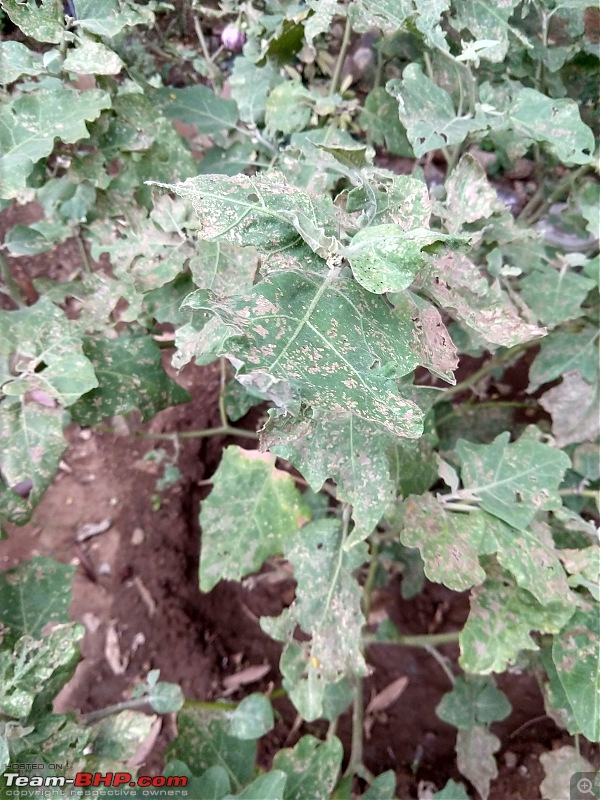
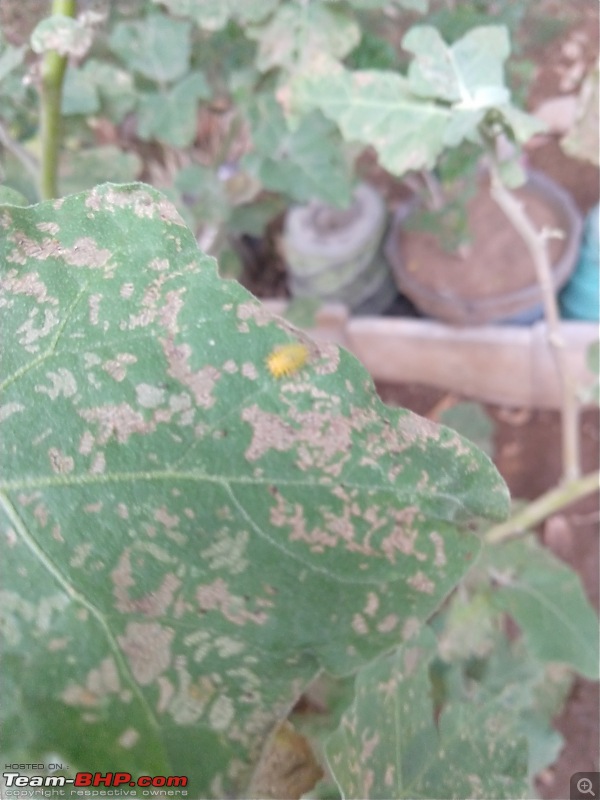
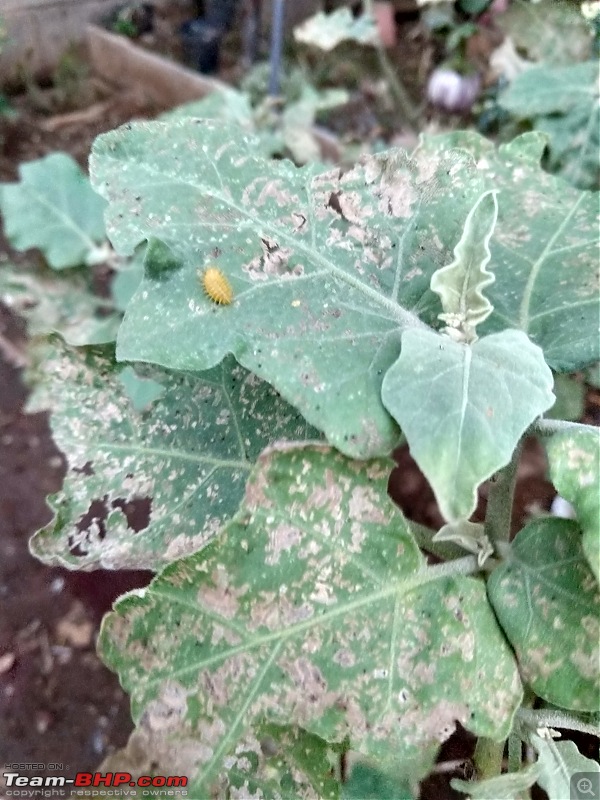
Quote:
Originally Posted by car FANATICUS
(Post 4456657)
Friends,
I have bought half an acre farm land near Bangalore, its a place called Holiday Valley. I want to grow a fruit bearing tree that does not require a lot of irrigation , as there is no borewell or water connection in my farm land. I visit the place once or twice a month for its 70 KM from my place , and if a tree can survive with that kind of watering frequency , I am interested to know.
My plan about this plot is long term , hence do not want to invest in a small setup right now. Advice appreciated.
|
Hi. I think you can employ a buried clay pot irrigation method to water your tree at least for the first few months of is life.
https://www.sciencedirect.com/scienc...78377400001190
Quote:
Originally Posted by car FANATICUS
(Post 4456657)
Friends,
I have bought half an acre farm land near Bangalore, its a place called Holiday Valley. I want to grow a fruit bearing tree that does not require a lot of irrigation , as there is no borewell or water connection in my farm land.
|
Bangalore does get rain almost all round the year isn't it?
Big trees need care only for the first year once they get past the 2nd monsoon they have grown a fairly deep root system and don't need frequent watering. If the water table is only 20' deep then no watering is needed at all
To begin with you can experiment with Coconut and Date saplings.
Coconut - Get 10-15 brown coconut (the ones we use for cooking). Keep them half submerged in water for a month. Change the water every 2-3 days (change daily if your area has mosquitoes). You should see atleast some of the coconuts showing shoots. Continue till the shoots grow to 6-9"
Digup a pit 2'x2'x2' . Add 1' layer of compost. Put the coconut in the center then add more compost so that the roots formed on the coconut are completely covered. Level off the pit by adding soil. Water thoroughly
Then cover 4'x4'x4' area with mulch (dried leaves are perfect). The mulch will prevent evaporation and also turn into compost in a few months.
Date - Get Khajur (the one with seeds). Eat the pulp wash and dry the seeds. Keep the seeds in a mildly damp cotton cloth in a plastic zip bag in a dark area. Check after 2 weeks. You should see sprouting. Move sprouted seeds into a grow bag. Let the saplings reach 6-9' in height. Then plant them in soil. Take care to not break the root. Date palms have a taproot system and the small sapling will die if the taproot gets damaged. Water only once a week and that too very little.
Rest do the same as coconut.
Both these trees grow vertically so best to plant them on the periphery of your property.
| All times are GMT +5.5. The time now is 13:35. | |







